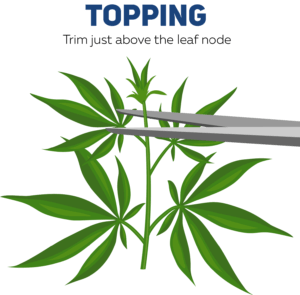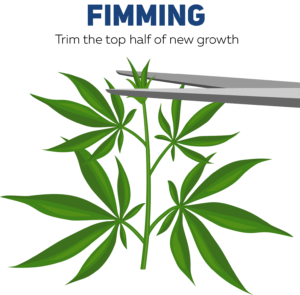When growing cannabis, you may have heard about topping your plants to increase yield or control the vertical height of your crop.
But what is “topping” and how can it help your plants? In this article, we’ll discuss why some growers choose to top their plants as well as industry tips on how to do so safely and effectively.
Topping Cannabis
Depending on strain, most cannabis plants grow tall and thin toward their light source, giving them their classic Christmas tree shape. However, there are stress training methods that can be used to control your plants heights and shapes.
Pruning is a common plant training technique in which small sections of the plant are trimmed away to promote healthy growth in other areas of the plant. Topping involves a particular method of pruning in which the top of the plant is removed. It is usually performed during the vegetative stage after the plant has developed strong enough to withstand the added stress.
What Does "Topping Cannabis" Mean?
“Topping” refers to the process of trimming the uppermost growth from the plant to promote fuller, bushier growth. This is a common plant training technique in which the goal is to stop the plant from growing taller, create two new branches that can support more buds, and divert energy into lower branches and buds.
Topping can encourage lateral growth of the branches as well as multiple colas, which can increase the yield of the plant by promoting shorter plants with more buds. This is a popular technique for growers using the sea of green (SOG) method.
Topping vs. Fimming
When considering topping a cannabis plant, you may also come across the term, “fimming.” The term is actually an acronym for “F***, I Missed!” This was derived from growers attempting to top their plants and cutting in the wrong spot. However, some cultivators have come to prefer the FIM technique as it can produce as many as 8 new stems rather than just two.
Topping and fimming are both techniques used to encourage lateral growth in cannabis plants. The technique you use will depend on your personal preferences.
- Topping involves cutting off the main stem of the plant just above a leaf node (where the leaves branch out). This encourages the plant to grow laterally, rather than vertically.

- Fimming is similar to topping, but instead of cutting off new growth at the main stem, you only remove the top half of the new growth.

The primary difference in the results of topping vs fimming is that topping cannabis at the stem will promote the growth of two new Y-shaped stalks, whereas fimming will promote the growth of several new stems (typically 2-4). Because of this, plants that have been fimmed will require more trellising support than those that have been topped.
When to Top Cannabis Plants
Pruning, trimming, and plant training in general can be stressful for plants. It’s important that you allow your cannabis to develop enough before topping. Topping too early or while the plant is showing signs of damage or disease could seriously harm it.
Generally, your plants will be sturdy enough to begin topping when:
- The plant is at least 30-days old
- The plant has developed 4-7 nodes
Most growers top their plants early in the vegetative stage when plants are still relatively small. It’s typical to top plants 1-3 times throughout the veg cycle. Again, topping can be stressful, so observe you plants for about 2-weeks between toppings to ensure they are healthy enough for further trimming.
It is absolutely critical to top your plants before the flowering stage. Once it has begun flowering, your pant’s energy will be dedicated primarily to bud production, not lateral growth, and any topping that you do at this stage will have the opposite of the intended effect (ie, fewer bud sites).
Things to Consider Before Topping Cannabis
There are a few reasons why professional growers might want to top their plants. Topping can help to even out the canopy, promoting better light distribution and preventing etiolation (stretching) of the lower leaves. Additionally, topping can encourage more even growth overall, leading to healthier and stronger plants.
Of course, the plant training routine you opt for will largely depend on your available space, strains, labor, and personal preference. If you are trying new plant training methods, we recommend performing tests on a small section of your grow first to determine if you will achieve the kind of results you hoped for.
Potential Benefits of Topping Cannabis
Topping cannabis plants can have a number of potential benefits. For example, topping can increase yield, as more buds are produced on the main stem.
Topping can also help to promote bushier growth, which can be beneficial in terms of increasing the surface area for light and air exposure, as well as increasing the overall number of buds.
Finally, topping can also help to create a more even canopy, which can improve light penetration and prevent shading issues.
Potential Drawbacks of Topping Cannabis
It should be noted that topping cannabis plants can result in several drawbacks if done incorrectly, including:
- Stunted growth – Topping can also stunt the growth of a cannabis plant, as it can reduce the amount of energy the plant has available to put into new growth. When topping is done properly, the result is generally a larger number of smaller buds whose combined yield is greater than it would have been prior to topping.
- Increased risk of disease – When you cut off the top of a plant, you open up the plant to potential disease and pests, so it’s extra important to ensure that biosecurity SOP’s are followed and the environment is properly maintained. However, pruning can also help increase air circulation around your plants, which can help prevent mold and mildew.
- Damaged leaves – If done incorrectly, topping can damage the leaves of a cannabis plant, which can impact the plant’s ability to photosynthesize and produce food for itself.
- Stress – Cutting away at a plant will stress it. However, some stress can be beneficial to plants.
- Hermaphroditism – Topping can potentially increase the risk of hermaphroditism. This is a condition in which a plant produces both male and female flowers, and can be problematic for growers because it may lead to seed production, which can reduce the quality and potency of the buds.
Ultimately, whether or not you decide to top your plants is a matter of preference. Be sure to do your research and weigh the pros and cons before making any decisions.
Pruning
Pruning is a common plant training technique for controlling the direction of new growth and removing damaged or unnecessary sections of the cannabis plant. Pruning involves selectively removing leaves, branches, and other parts of the plant in order to promote better air circulation and light penetration.
Some best practices for pruning cannabis include:
- Prune primarily during the vegetative stage – While some experienced cultivators do prune in early flower, most pruning activity should take place during vegetative growth.
- Prune sparingly – Start by removing any dead or dying leaves and branches. Then, carefully trim back any excess growth. Don’t go overboard and allow time between pruning to observe the plant for any indications of over-stressing. In general, you’ll want to remove leaves and/or stalks that are blocking light to important parts of the plant, or that aren’t receiving sufficient light to produce useable buds.
- Use clean, sharp scissors or clippers – A good pair of shears will help limit damage to the plant and make pruning more efficient. Ensuring that your tools are sterilized will ensure that you don’t infect the plants your are pruning with fungus or pathogens.
- Cut branches at a 45-degree angle – Pruning at a 45-degree angle will promote faster healing and prevent water from pooling on the cut surface.
- Remove diseased or damaged leaves and branches – keeping your garden clean can help create better growing conditions for the remaining branches and nodes.
- Dispose of pruned material properly – It’s important to maintain a clean, sanitary grow room, and to stay in compliance with state and local regulations.
Potential Benefits of Pruning Cannabis Plants
Pruning can be beneficial for a number of reasons. For one, it can help to prevent the spread of diseases and pests. Additionally, pruning can improve the yield and quality of your plants by promoting better light distribution, more homogenous temperature and humidity, and encouraging more vigorous growth.
Potential Drawbacks to Pruning Cannabis
Pruning is a fairly invasive procedure, and if not done correctly, can damage, shock, or even kill your plants. Be sure to do your research and talk with experienced indoor cannabis growers before you take shears to your plants.
Want to Learn More About Cannabis Cultivation?
Surna Cultivation Technologies is the one-stop-shop for commercial indoor cultivation facility design. With over 15 years of experience in the cannabis industry, we’re dedicated to bringing you the latest in grow room information and tips. Subscribe to our newsletter to receive a weekly list of resources filled with articles related to cannabis cultivation, videos, downloadables, and more.

